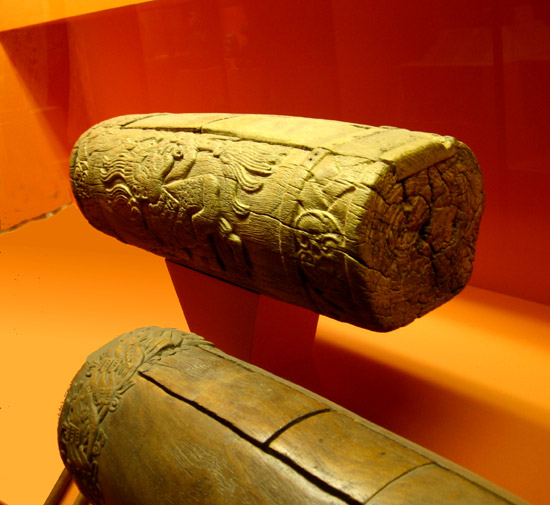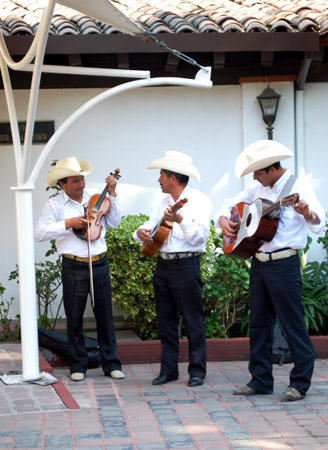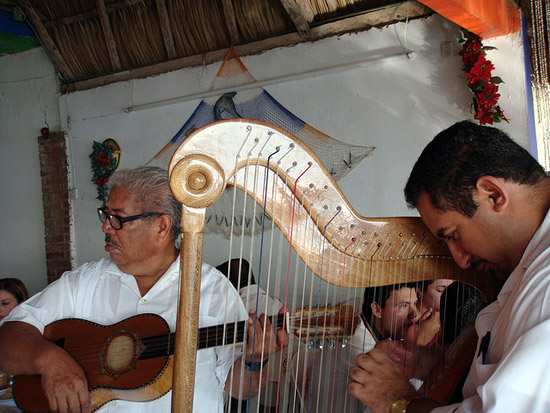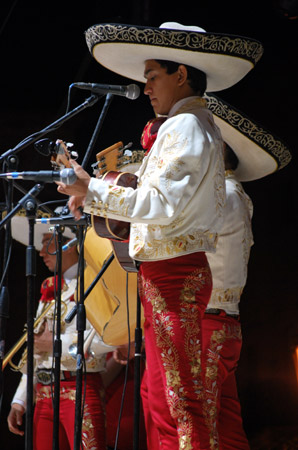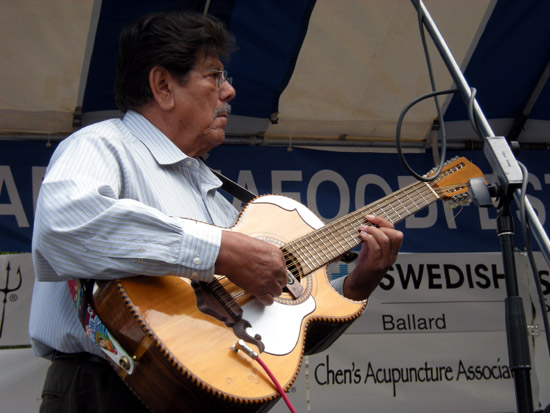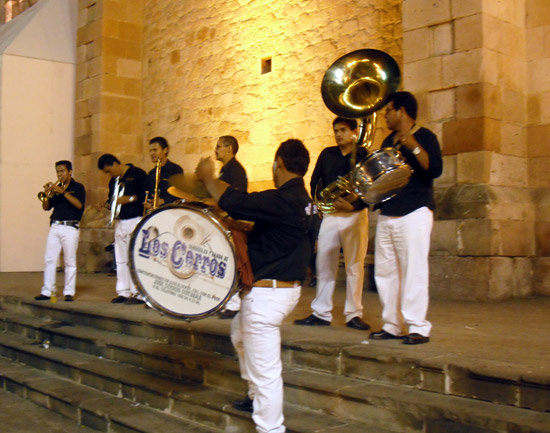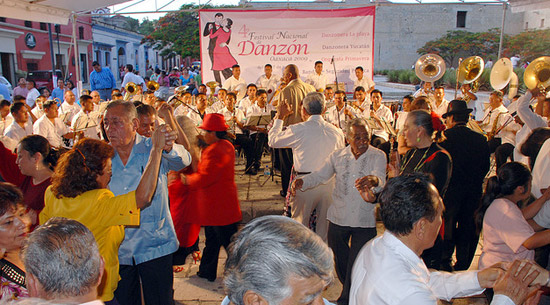Music: Traditional Forms
Indigenous Forms
Mexico’s predominantly mestizo population (representing around 60 percent of the nation’s total) may be a contributing factor to a shortage of investigation regarding indigenous practices. Researchers have been able to surmise many details about Aztec musical traditions due to the sheer magnitude of available archaeological evidence of the Aztec Empire’s rise and fall, but similar clues are not available for the plethora of tangential cultures that have also called Mexico their home.
As indicated earlier, however, there are some common themes that seem to prevail among the varieties of native music that have been studied: musicians were important and often privileged members of society, their craft was passed on orally, and it was used for ritual and ceremonial purposes—sometimes in conjunction with sacrifices—related to religion and war. Unfortunately, the Spanish colonists shared this interest in warfare, and in many primary sources their contemplations on the subject overshadow reports on art and music.
The newcomers’ unwillingness to preserve native traditions was not always so passive, however. During the Inquisition, indigenous music was outlawed as part of a campaign to exterminate all non-Christian systems of belief and expression. Luckily, many ancient instruments have been discovered, and a select few (drums, rattles, and flutes) are still in use today.
Aztec lords had chapels in their homes where composers, singers and dancers produced works to be performed at festivities that took place every 20 days. Music was not exclusively for entertainment, but also for educational purposes like cultivating religious and cultural knowledge. Furthermore, certain children were sent to formal music schools called cuicalli, and lessons learned there were reinforced by elders at home. Sacred hymns commemorated and displayed gratitude for great deeds of gods and legendary rulers. They also provided a means to petition for rain or military success. Lyrics were often poetic and symbolic, brandishing the highly evolved Nahuatl language in which they were written. Participants in accompanying dances required special training and great endurance, as the trance-like rituals could last for hours.
Canción Ranchera
Rancheras (from the Spanish rancho or “ranch”) are songs from, and about, the rural countryside of Mexico. Like the corrido, the ranchera began formulating its identity—rooted in traditional folk music, originally sung by a single performer with a guitar— during the Mexican Revolution, and can be interpreted as a symbol of opposition to the spreading aristocratic ideals of the period.
Rancheras vary in tempo more than corridos, occurring in 2/4 (like the polka), 4/4 (a variation of the bolero), and 3/4 (resembling the waltz). Their lyrical content is also distinct: rather than epic tales of heroes and villains, the ranchera tends to treat themes of love and nature. As in other forms of Mexican folk music, instrumental interludes feature the spontaneous grito or “scream” of musicians and audience members alike (the rough equivalent of a “yeehaw” at a hoedown). While rancheras are most closely associated with mariachi groups, it is important to note that norteño and banda ensembles also perform them, and that mariachi repertoires include many other song forms as well.
Son
The word son is an abbreviation of the Spanish word sonido (“sound”) and refers to a broad category of rural Mexican folk music. During the colonial era, the distinction was made between música (music of the court and Church) and the son, originally a derogatory term for the “noise” being made elsewhere. Sones vary by region and culture, often fusing indigenous, Spanish, and African elements. Many are in triple meter (3/4, 6/8, or a combination of the two) and share the identifying characteristic of the zapateado (rhythmic striking of the zapato or “shoe” on the ground, derived from the Spanish flamenco tradition) as part of a coupled social dance accompanying small musical ensembles typically led by stringed instruments.
Son Huasteco
The son huasteco is associated with the complex huapango rhythm (from the Nahuatl cuauh-panco, meaning “atop a wooden platform,” where accompanying dances would have taken place in Aztec times) and is most vigorous in the Mexican states of Puebla, Veracruz, Hidalgo, Tamaulipas, and Querétaro. The son huasteco’s text is an improvisational version of the Spanish décima (10-line stanza of sung poetry), while the music is performed on violins and a combination of guitars underneath falsetto vocal flourishes.
Son Jarocho
The son jarocho from the coastal plains of Veracruz and southern Tamaulipas represents Mexico’s most quintessentially Creole musical phenomenon, combining indigenous, Spanish, and Afro-Caribbean qualities. With a repetitive structure and improvised (often humorous, even “offensive”) lyrics—again, divided into décimas—many jarocho songs feature African-derived call and response and Cuban claves. The son jarocho is most easily identifiable by the arpa jarocha, a wooden harp native to the region. A typical ensemble combines two harps with guitar relatives known as the requinto and jarana. A classic example of son jarocho is “La Bamba,” made popular internationally by Ritchie Valens in the 1950s.
Son Jaliscience and Mariachis
Son jaliscience comes from the state of Jalisco, the birthplace of mariachi, and because of the popularity of Mexico’s most recognizable ensemble throughout the country (as well as abroad), their trademark songs have become some of the most widely known and beloved in the region. Wherever mariachis are present, serenatas (romantic “serenades”) also abound. Most sones jaliscienses have strophic forms, alternating between coplas—describing animals and people from the countryside, sometimes masking scandalous human subject matter behind cryptic depictions of bestial mating, for example—and musical interludes with fixed melodies. The songs are rhythmically complex, dancing between 3/4 and 6/8 time signatures with quick, precise strumming patterns on the guitar and its relatives.
For years the belief was that the word mariachi derived from the French mariage (“marriage” or “wedding”), an occasion at which the very danceable style has always been popular; but this theory was discredited when it was discovered that the word was already in use prior to the arrival of French imperialism under Maximillian I. The current consensus is that the word has native roots, and one theory suggests that it evolved from a term describing the platform upon which musicians and dancers stood at village performances.
Today, a complete mariachi ensemble consists of a combination of violins, trumpets, guitars, vihuelas, guitarrónes, and the occasional harp. The ornamented garb of the mariachi, the traje de charro, normally consists of sombreros, delicately embroidered waist-length jackets, and tightly fitting pants that open slightly toward the bottom, allowing space for short riding boots—ideal for the zapateado.
Son Calentano
Intricate foot stomping is also a fundamental element of son calentano or guerrerense (music from the Tierra Caliente region, the “hotlands” of Guerrero and Michoacán), but in this case the dancing is competitive. Fast-paced music is provided by guitars, violins, an occasional bass, and the tamborita (literally “little drum,” a percussion instrument with two skin heads over a cylindrical wooden body), with improvised décimas for lyrics.
Son Yucateco and Nueva Trova
Son yucateco (from the Yucatán Peninsula in the southeast) has a notable bolero-like flair, with striking harmonies and Caribbean undertones. Another Cuban form with an influence that resonates in the region is folk-based nueva trova, one of the branches of the nueva canción (“new song”) movement that swept across Latin America calling for social change. The jarana, a relative of the guitar, is a central instrument in much of the music performed in Yucatán, but is not to be confused with the other meaning of the word, which refers to a banda ensemble hailing from the region (which plays danza jarana).
Son Chipaneco
In addition to the various sones already discussed, there are other colorful regional embodiments of Mexican music. One of most exciting forms is the marimba music of Chiapas. The lush vegetation and rich wildlife of the region make it an appropriate setting for the tropical-sounding marimba, which arrived in Mexico and most of Central America with African slaves during the colonial era. Marimbas, which tend to be locally made, are accompanied by harps, wind instruments, violins, and percussion in performances of many Mexican forms including the local, waltz-like son chipaneco. As usual, foot stomping and partnered choreography take part in this vividly colored, costumed dance mirroring the flora and fauna of its birthplace.
Son Istmeño
The marimba’s influence extends as far west as neighboring Oaxaca, and sometimes it joins ensembles performing that region’s own son istmeño. While this form is strongly rooted in indigenous rhythms—over which the Zapotec language weaves romantic, picaresque lyrics—the melodic and harmonic structure are distinctly European. Son istmeño is most commonly heard at weddings and religious festivals.
Norteño
Also known as conjunto or música norteña, norteño is one of Mexico’s most popular musical genres. Its distinctive sound arose from the compelling juxtaposition of Teutonic styles (the waltz and polka inherited from the Germans and other Eastern European immigrants) upon Mexican and Spanish oral and musical traditions. Its instrumentation blends the button accordion and bajo sexto—complemented by combinations of bass, guitar, horns, and percussion—which collide animatedly at mid- to high tempos.
With frequent appearances of the grito, norteño sometimes acquires a certain rowdy quality. But despite having rural roots, the style has gained popularity in urban areas as well, and its audience includes large pockets of the southwestern United States. A spinoff in southern Texas, known as Tejano or Tex-Mex, is distinguished by its inclusion of rock, country, and swing elements. The modern-day narcocorrido also evolved from the norteño folk corrido tradition, and while its subject matter is glaringly unique, its musical base is performed by similar ensembles in which the accordion is the protagonist.
Banda
Originating in Sinaloa, a state of northwestern Mexico, banda is a brass-based form of Mexican music that erupted in popularity in the 1890s. Owing its polka roots and instrumentation—more specifically, horns, a staple in military bands—to the same European immigrants that catalyzed the cultural encounter resulting in norteño, banda’s songbook also includes traditional forms like the corrido and ranchera. Contemporary bandas (“bands that play banda”) perform genres ranging from pop to imports such as cumbia and bolero music.
A subgenre of banda music, tambora oaxaqueña, is prevalent in Oaxaca and has striking similarities to Balkan music (likely attributable, again, to the influx of southeastern European immigrants in the 18th and 19th centuries).
Like many Mexican ensembles, bandas are male-dominated, and in certain regions their tradition as village entertainers on special occasions survives. Alongside the brass, as well as woodwinds and percussion, banda’s standout instrument is the tambora, a makeshift drum kit. The heavy groove is provided by a sousaphone holding down the bass line—although the electric bass is substituted in modern “electrobanda”—while horns accent sharp upbeats in higher registers. Ensembles typically consist of between 10 and 20 members, with at least one singer and often extra voices (the grito is very common in banda as well).
Danzón
Evolved from the predominantly European contradanza, a dance music genre popular in 19th-century Cuba, danzón incorporates elements of African dance styles and rhythms. The creolized dance was initially deemed scandalous due to the sinuous hip movements and physical closeness of those performing it. Like other Cuban styles, danzón entered Mexico through Veracruz, where similar cultural and climatic conditions made for a warm welcome. The dance then spread to the ballrooms of Mexico City, and consequently throughout the country.
The slow, syncopated genre acquired a slightly higher tempo in Mexico, and in both countries the orquesta típica (“typical orchestra,” consisting of brass, violins, clarinets and kettledrums) that originally performed it was replaced by the more elegant charanga (ensemble comprising violin, cello, double bass, flute, guïro, and timbales). The dance is still popular today, in large part due to a revival that took place in the 1990s among older generations seeking to revisit their past through the style’s nostalgic movements and sounds.
Article written for World Trade Press by Dan DeMento.
Copyright © 1993—2024 World Trade Press. All rights reserved.

 Mexico
Mexico 